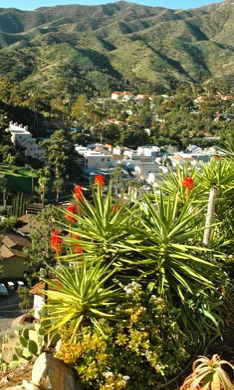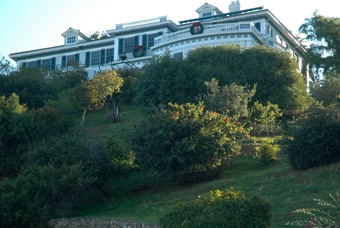Santa Catalina Island,
California
If you're thinking of going over, let us know. Advice is free!
Thanks for traveling with us.
P.S. from Tracy: If you have never been and want to surprise your loved one for a fun treat for a couple days, you can't go wrong with Santa Catalina.
Trivia answer: The Four Preps, 1958.

City of Avalon; relatively uncrowded in December
After a collective 120 years on this earth, we finally made it over to Santa Catalina Island during the December holidays. If you haven't gone over - and several of you have mentioned you have not been there but want to go - we recommend it.
Avalon, the only real city on the island is around the leeway corner of the far east end of the island. Total island population: 4,400 (85% in Avalon). The island is 22 miles long, 8 miles wide at its thickest. Contrary to the popular song - "26 miles across the sea, Santa Catalina is a waitin' for me..." - it's about 22 miles SSW of Los Angeles. The highest point is 2,097 feet.

[Trivia time: Who sang "26 Miles" and when? Answer at the end.]
Archaeologist digs date early native inhabitants back to 7000 BC. It was known for its quantities of soapstone; in modern times, it's known for tile. The first European to discover the island was the Portuguese explorer (sailing for Spain) Juan Cabrillo (1542) who named it San Salvador, after his ship. It was "re-discovered" by Sebastian Vizcaino (1602) on the eve of St. Catherine's Day, and he named it Santa Catalina after her. Vizcaino's ancestors (Jose and Luis) later played shortstop in the major leagues, mostly in the National League. They played too late to have been part of the Cubs' training facilities on the island.

The view of Avalon and the harbor, looking north, from the Wrigley mansion


We went over from Dana Point (90 minute ferry ride), fortunately on a nice, calm day (more on that later). Except for a huge cruise ship in port (people needed to take a boat ride to the wharf from the ship's anchoring), it was quite a sight as we cruised into the harbor (a little choppy for good pictures, though). And we were treated to two gorgeous days as we hiked around (up and down and around, actually, as you can see from the photos) the incorporated town of Avalon (Los Angeles County). The town was far more pleasant when the cruise ship left later that day, so you might want to plan your visit when the ship is not in town.
When you hike up the roads on both sides of the harbor, you're treated to great views. These are taken from the south side (up by the Wrigley mansion, now a bed and breakfast, we were told). The harbor, of course, is full of sailboats and cabin cruisers during the tourist season. The two buildings high on the hill across the harbor are the Zane Grey Pueblo residence and the Bell Tower (more on those later). We hiked up here at night, too, but I didn't have a tripod with me, so night shots were not practical.
As picturesque as this place is, the harbor is considered one of the most polluted in the state, thanks in large part to a decaying sewage infrastructure. Locals don't like your bringing that up, however.

This is the Avalon Yacht Club. In the background is the "Casino," which, as you might expect when built by a Seventh Day Adventist, was bereft of gambling. It was a movie theatre and ball room: a place for social gatherings.

Look down onto the sandy beach in the photo above. Do you recognize Tracy with her arms raised in the air amid the palm trees (right in the center of the pic)? Well, it IS her! Our hotel is left of her (Pavilion Hotel: we recommend it; we understand - now we do, at least - that you can buy packages that include the ferry, tours and the zip line, as well as other attractions). We passed on the zip line; it did not look as interesting or as scenic as some of the ones we have heard about in more exotic climes - say Hawaii or Central America. Maybe next time.


A better photo of our hotel - from the wharf; these boats were for rent; they were not there on our last day (more on that later).
Most of the "cars" on the island are golf carts. (It takes several years to get a permit for a real car or truck, which is why people horde their permits.) Which gives you street scenes like this:


I asked someone if they knew how many were gas vs electric, but all he could say was the air quality improved when they went to four-stroke engines; the newer carts tend to be electric, though.
This was one of our favorite "tourist" shops. Every piece of art in this place was made locally by a handful of artists - and each piece is fish-related. Unfortunately, it was closed for the holidays when I went back to take photos, so through-the-window shots will have to do:



William Wrigley, Jr. owned most of the island as part of the Santa Catalina Company in the early and mid part of the 20th Century (by 1919 he had bought out most shareholders of the company). His impact is seen everywhere (and why most of the island is undeveloped; in 1975, his son deeded the land to the Catalina Conservancy, which Wrigley helped found). His Chicago Cubs trained on the island from 1921-1951 (except during WW II), although there are no remnants left other than a practice field backstop. His mansion sits atop a hill overlooking the harbor.
High up on the hill in the left photo, you can see the mansion (above that long white ribbon of a wall along the road we hiked).


Another nice hike was up the other side of the island toward author Zane Grey's old home:


The local legend is that Zane Grey was not the most pleasant person on the island, but Ada Wrigley loved throwing parties and always invited Mr. Grey. He sometimes came - but rarely RSVP'ed - and was usually late for dinner parties. This did not sit well with the prim and proper Mrs. Wrigley, and some say, in retaliation for his behavior, she installed bell chimes within a hundred yards of the Grey residence. Imagine you're an author - a prolific author - and you've got these bloody chimes going off every 15 minutes! When Mr. Grey finally left the island, he was not missed.
Less than 100 yards up the road, Ada's bell chimes:


Ada Wrigley also opened a botanical garden on the island, either a walk or a short bus ride from town; this is taken from the Wrigley monument at the far end of the gardens, looking east toward Avalon and the mainland. Worth a visit.

The highlight of our stay was a personal three-hour jeep tour of the south part of the island with an almost-80-year-old docent who has lived on the island for 49 years. He was a delight. Ask for Fred when you book an eco-tour with the Catalina Conservancy.
About 400 species of native plants grow on the island, and six of those grow only on this island.





Our ferry did not leave until 4:30 our third day, so we were supposed to have another day to roam the city - and perhaps head up a hiking trail. But a fierce (and predicted) wind hit early that morning, and it was near gale force most of the day. There was concern that our ferry - which sailed mostly at night - would be cancelled. We did not know until about 4:00 p.m. that it intended to sail. So I downed a couple of tabs of Bonine for the trip. Money well spent, as it was an E ticket ride most of the way back to Dana Point.
All of the small boats were taken further out into the harbor to be moored, and there were guys surfing in the inner bay. Flags were stiff at attention all day long.
Hard to tell from this pic, but the flag gives the wind the way a little bit. This is the Tuna Association building. It's said that this island, the get-away for the rich and famous (e.g., Humphrey Bogart, Clark Gable) during the time the Wrigleys lived here, was the original home of sport fishing. And, if you've forgotten, it was in this harbor where Natalie Wood drowned.

No, I did not take this picture, but this shows the city of Avalon on the lower right side, this photo taken looking north. The terrain is far more rugged than you might expect. There's a sizable heard of bison on the island - brought over for a movie during the 1920s (they've managed the herd, which was getting too big, by shipping some of the bison to an Indian reservation in South Dakota). We did not see bald eagles (except for an injured one in captivity) or foxes, but they can be seen on the right day.
